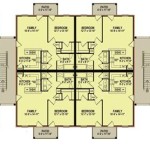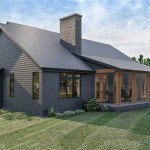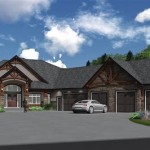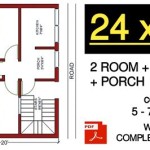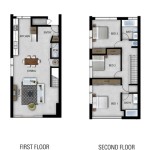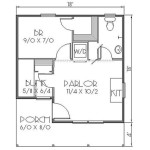Maximizing Space and Efficiency: Exploring 500 Square Foot House Plans
The concept of the "tiny house" has gained significant traction in recent years, fueled by a desire for simplified living, reduced environmental impact, and financial freedom. At the core of this movement lies the challenge of designing functional and comfortable living spaces within limited square footage. A 500 square foot house plan represents a particularly intriguing design problem, demanding ingenuity and careful consideration of every inch of available space. This article delves into the key principles and considerations involved in creating effective 500 square foot house plans, exploring the elements that contribute to a livable and enjoyable small home.
Designing a 500 square foot dwelling requires a shift in mindset. It necessitates a prioritization of needs over wants, a commitment to minimizing clutter, and an embrace of multi-functional design elements. The success of such a project hinges on a clear understanding of the future occupant's lifestyle and daily routines, allowing architects and designers to tailor the space to perfectly suit their individual needs.
Strategic Space Planning: The Foundation of a Functional Tiny Home
The initial stage of designing a 500 square foot house revolves around strategic space planning. This involves carefully considering the layout of the home, the placement of rooms, and the circulation patterns within the limited area. A well-designed layout can create a sense of spaciousness, while a poorly planned one can feel cramped and claustrophobic.
Open-concept living is a common and effective approach for small homes. Combining the living room, kitchen, and dining area into a single, unified space eliminates the need for dividing walls, thereby maximizing the available square footage. This arrangement promotes a sense of openness and allows for greater flexibility in furniture arrangement and usage.
Vertical space utilization is also crucial. Lofts can be incorporated to create sleeping areas, freeing up valuable floor space below for living or storage. High ceilings, even without a loft, can contribute to a more airy and spacious feel. Shelving that extends to the ceiling provides ample storage without consuming valuable floor area.
Careful consideration must be given to the placement of the bathroom. While it is necessary, bathrooms often require a dedicated space that can feel disproportionately large in a small home. Compact fixtures, such as wall-mounted toilets and corner sinks, can help to minimize the bathroom's footprint. Showers are generally preferred over bathtubs due to their space-saving nature.
The kitchen, typically a crucial space, requires intelligent design. Compact appliances, such as a two-burner cooktop and a small refrigerator, are essential. Counter space can be maximized through the use of pull-out extensions and foldable surfaces. Strategic placement of storage solutions, such as drawers and shelves, is crucial for keeping the kitchen organized and functional.
Consideration should also be given to natural light. Large windows and skylights can significantly enhance the feeling of spaciousness and brightness within the small home. Proper window placement can also contribute to passive heating and cooling, reducing energy consumption.
Multi-Functional Furniture and Storage Solutions: Optimizing Every Inch
In a 500 square foot home, furniture must serve multiple purposes. The selection of multi-functional furniture is paramount to maximizing space and minimizing clutter. Each piece should be carefully chosen for its ability to adapt to different needs and situations.
Sofa beds are a classic example of multi-functional furniture. They provide comfortable seating during the day and can be easily converted into a bed at night. Similarly, ottomans with built-in storage offer both seating and a place to store blankets, pillows, or other items.
Foldable tables are another valuable asset in a small home. They can be easily folded away when not in use, freeing up floor space for other activities. Wall-mounted desks can also be folded down when needed, providing a workspace without permanently occupying floor space.
Built-in storage solutions are highly effective for maximizing space. Custom-built shelving units, cabinets, and drawers can be tailored to fit the specific needs of the occupants and the unique dimensions of the home. Storage solutions can be incorporated into walls, under stairs, and even under the bed.
Consider vertical storage solutions extensively. Utilizing the height of the walls with shelving and cabinets allows for ample storage without taking up valuable floor space. Hooks and hangers can also be used to organize items such as clothing, tools, and kitchen utensils.
Transparent storage containers can be used to keep items organized and easily accessible. This allows occupants to quickly find what they need without having to rummage through multiple containers. Labeling storage containers is also helpful for maintaining order and minimizing clutter.
Material Selection and Design Aesthetics: Creating a Sense of Spaciousness and Comfort
The choice of materials and the overall design aesthetic can significantly impact the feeling of spaciousness and comfort in a 500 square foot home. Light colors, reflective surfaces, and minimalist design principles can all contribute to a more open and airy environment.
Light-colored walls and ceilings can make a room feel larger and brighter. White, cream, and pastel shades reflect light, creating a sense of openness. Dark colors, on the other hand, can make a room feel smaller and more enclosed.
Mirrors are a powerful tool for enhancing the feeling of spaciousness. Strategically placed mirrors can reflect light and create the illusion of more space. Large mirrors on walls or closet doors can be particularly effective.
Minimalist design principles are well-suited for small homes. A minimalist approach focuses on simplicity, functionality, and the elimination of unnecessary clutter. By reducing the number of decorative items and furniture pieces, a minimalist design can create a more calming and spacious environment.
Consider the use of natural materials, such as wood and stone. These materials can add warmth and texture to the space, creating a more inviting and comfortable atmosphere. Natural materials can also help to connect the home to its surrounding environment.
Pay attention to lighting. A well-lit home feels more spacious and inviting. Combine natural light with artificial light to create a balanced and comfortable lighting scheme. Use a variety of light sources, such as overhead lights, task lights, and accent lights, to illuminate different areas of the home.
The flooring choice is also important. Light-colored flooring can make a room feel larger, while dark-colored flooring can ground the space. Consider using continuous flooring throughout the home to create a sense of flow and continuity. Avoiding area rugs can help to visually enlarge the space.
Careful attention to detail is key to creating a successful 500 square foot house plan. By prioritizing strategic space planning, multi-functional furniture, and thoughtful material selection, it is possible to create a functional, comfortable, and enjoyable living space within a small footprint.

Small House Plan Idea 500sqft

Housing Plan For 500 Sq Feet Simple Single Floor House Design Houseplansdaily

500 Square Foot Smart Sized One Bedroom Home Plan 430817sng Architectural Designs House Plans

Farmhouse Style House Plan 1 Beds Baths 500 Sq Ft 116 129 Houseplans Com

Under 500 Sq Ft House Plans

2 Bhk House Plan In 500 Sq Ft Gharka Naksha Rjm Civil

500 Sq Ft House Plans Modern 20x25 Houseplan

Plan 76166 Tiny Floor Under 500 Sq Ft Has 2 Bedrooms And 1

Single Bedroom House Plans With Staircase Under 500 Sq Ft For 120 Yard Plots Small Hub

House Plans Under 500 Square Feet

